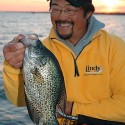By Ted Takasaki and Scott Richardson
Hall of Famer Ted Takasaki with a dandy springtime crappie caught using the system described in this article. Mr. Slip Bobber, Greg Bohn, outlines what you need to know to find and catch crappies as they seek warmer water in the spring.
When north woods guide, Greg Bohn, fishes for crappies in the springtime, all he needs is a boat equipped with a Humminbird sonar/temperature gauge and a Thill slip bobber.
“Water temperature is the key. It’s the driving force of where crappies are going to be that day,” said Bohn. “They don’t care about food… nothing but warm water.”
That fact holds true whether it’s a reservoir or a natural lake, he said. A difference in a degree or two is all it takes to hold crappies by the bushel or none at all.
As for slip bobbers, Bohn has been known as Mr. Slip Bobber for perfecting one of the most used and least understood methods to catch a wide variety of fish, including crappies and walleyes. He authored (with Scott Richardson) the book “Mastering the Art of Slip Bobbering: The Deadliest Method for Walleye!” which is in its fifth printing.
Bohn knows from experience there may be no crappies on a main-lake point, but motor back into an adjacent bay as far as you can into shallow water and there they’ll be. You might be able to even see them with a good pair of sunglasses. The difference from one spot to the other is that shallow, protected water warms faster. Add a breeze blowing warm surface water into the bay and the effect is even more phenomenal. They might not bite when the surface is calm, but let the wind rough it up and action can become furious, he said.
This pattern holds true from the time water reaches about 45 degrees until it hits the 60-degree mark, he said. Maybe instinct tells them to search out the warmth to lay their eggs. They aren’t talking. But be confident, warmer water is the place to start.
Standing timber in the water accelerates the process. Water may be colder than you’d expect but the sun warms this wood which warms the water surrounding it. Bohn loves to check out stump fields in the back of bays at this time of year.
He also stumbled on another fact. While fishing the shallow water surrounding a stump field, he saw crappies on the screen right below him in slightly deeper water 6 to 7 feet down. Slip bobbers next to the boat started catching them, too. The lesson – not all of the fish are at the same stage in the reproduction cycle all at one time. Some are shallow, and some are holding deeper waiting for their right time.
“Crappies can show up in the most unexpected places,” he said. “It was really an awakening and learned something that day. I was having action in the shallows and by the boat. They were more aggressive by the stumps where the water was warmer. They were defending and protecting their nests. But the really big ones were in the deeper water.”
No stumps? No problem. Look for shallow, protected water with wood of any kind. Brush piles. Blow downs. Any wood above water to warm can transfer heat beneath the surface. The result will be the same -crappies for dinner. In reservoirs, the best bays will be closest to the points that reach to the main channel. They won’t go from one end of the lake or reservoir to the other in search of warm water, but they’ll find the warm water in the area of the lake they’re in.
The heat is what they want.
Bohn has devised a perfect slip bobber rig that is sensitive to the lightest of bites while allowing an angler to target exactly the depth they want without hassle.
Bohn’s design starts with a bobber stop made out of thread to avoid line damage.The tags of the knot are carefully tightened and trimmed to 1 inch. The bead is made of red glass so it slides easily and can be seen from a distance.The bobber can be either weighted or unweighted, which depends upon whether he’s casting into wind or not. A barrel swivel is added to the line, then a monofilament leader. A rubber core sinker midway on the leader is added to balance the rig. Don’t twist the rubber to secure the weight. Just slide the line behind the core. That way, it will slide and free itself if it gets hung up in the wood.
Lindy Fishing Tackle has assembled Bohn’s components into the Thill Pro Series Floats or Rigs that have everything you need including a tiny flicker blade. It flashes in the sun as the crappie-sized minnow hooked behind the dorsal fin swims beneath the bobber or as the wind creates wave action. Always make sure to use fresh bait.
Stick with a small minnow early in the season. Try small plastic baits, like the Lindy Dancin’ Crappie Tube Jig (designed by Bill Dance) as water warms into the mid to upper 50s. If state law allows, set out the slip bobbers and use another rod with a Dancin’ Crappie Spin Jig to cast the area and cover more water.
If action stops, give the spot a rest and go find another. Return later for more fish. You may have a milk run of several spots by the end of the day. Move from one spot to the next.
Crappies in the livewell – there’s no better way to warm up to spring than that.
